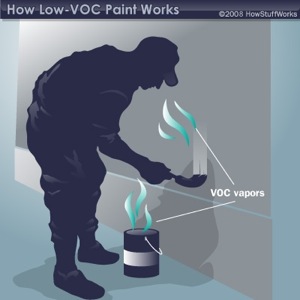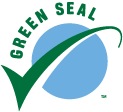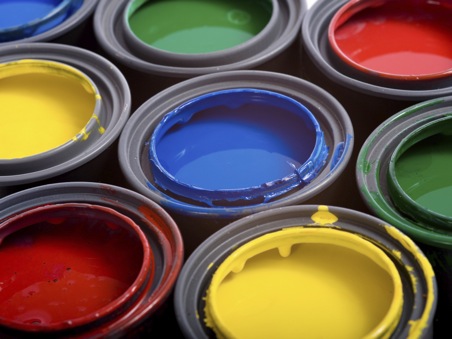You know that new paint smell? Does it every give you a headache or irritate your sinuses? That’s because most paints contain VOCs – volatile organic compounds. VOCs are a class of carbon-based compounds that readily become volatile under ordinary atmospheric conditions. In other words, they are gases that are emitted from certain solids or liquids, and they can have adverse health effects.
According to the Environmental Protection Agency (EPA), VOCs are emitted by a wide array of products numbering in the thousands. Examples include:
- paints and lacquers
- paint strippers
- cleaning supplies
- pesticides
- building materials and furnishings
- office equipment such as copiers and printers
- correction fluids and carbonless copy paper
- graphics and craft materials including glues and adhesives, permanent markers, and photographic solutions.
What’s the health risk?
There are many known health risks to VOC exposure: Eye, nose, and throat irritation; headaches, loss of coordination, nausea, memory impairment; damage to liver, kidney, and central nervous system; allergic skin reaction; fatigue and dizziness.
Similar to exposure to other toxins, the health effects vary dependent on the length of time exposed, the concentration of the substance that contains the VOCs, and the overall level of toxicity.
VOCs are also large contributors to pollution and smog. In Southern California, the Air Quality Management District estimates that 13% of the ozone-forming pollution comes from paints and solvents.
If it’s bad for you, why is it added?
Paints are made up of solids – pigments for color, and binders that hold the particles of the pigment together – as well as liquids, which are called solvents. Solvents can be water-based (as in latex paint and are low-VOC), or petroleum distillate-based (high VOC content), and in both cases they serve the function of being able to literally paint the pigment on the surface. The solvent then evaporates so you are just left with a film of color.
Then there are the “additives,” which are ingredients that make the paint unique. Some additives, specifically co-solvents, are VOCs. They are added to help the paint form a good film and enhance brushing properties. So…the next logical question would be to wonder whether no-VOC paints and finishes actually do the job well. After all, the chemicals that contain VOCs were added for a reason, right?
What constitutes “low” VOC?
To understand what you are buying, the best thing to do is read the label on the paint. The federal limits that defi ne “low” and “no” VOC are based on the number of grams per liter (g/L), as follows:
ne “low” and “no” VOC are based on the number of grams per liter (g/L), as follows:
| Latex and Flat finish Paints | Oil-based and All Other Paints | |
| Low-VOC Paint | < 250 g/L | < 380 g/L |
| VOC-free Paint | < 5 g/L | |
Many states and regions have lowered the VOC levels from federal levels for paints that can be legally sold in their areas. California’s South Coast Air Quality Management District (SCAQMD), for example, set a more stringent standard for VOCs in order to reduce the smog in that area. These SCAQMD standards, also the ones adopted for LEED Certification (Leadership for Energy and Environmental Design, an internationally recognized high performance green and healthy certification program for buildings), are set for all types of architectural and specialty applications such as sealants, adhesives, primers, and foams. For paints in particular, the VOC limits are set at a maximum of 200 g/L for exterior nonflat paints and 100 g/L for exterior flats.
Does low-VOC paint work as well?
According to Consumer Reports’ Paint Buying Guide, “earlier low-VOC paints lacked the durability of higher-VOC finishes, but now all of the paints in our tests are claimed to have low or no-VOCs and many performed very well.”
For interior paints and sealants, it has been my personal experience that there is absolutely no difference in quality, and there is an enormous difference in smell. It is truly amazing to walk into a home that was just painted with no-VOC paint, and there is virtually no smell, no headache, and no dizziness.
What’s more, the painters appreciate it! They have to work every day with exposure to toxins, and they can really tell the difference. The times I have had work done on our house, the painters have specifically thanked me for choosing those types of paints and sealants.
For exterior sealants, however, I have yet to find a low-VOC product that works well. The problem is that most water-based paints and sealants do not provide a protective coating for exteriors that ward off rain and snow. But, it is outside and can air out more quickly than indoor paints. And, as standards become more stringent, more products that can do the job well are becoming available.
Does low- or no-VOC paint cost more?
It is difficult to compare costs of paint, because branding, distribution, quality, the number of coats you’ll need, etc. have a lot to do wi
A competing product, Jeff Lewis Color brand at Home Depot is “ultra low VOC” (less than 15 grams per liter,) – so not “no-VOC” but still pretty good. This sells for $39.98 per gallon at Home Depot: $4 more per gallon, and a little less healthy. So while this is just one example, I would definitively say that you do not need to pay more for low or no-VOC products. Besides, paint is one of those things not to skimp on, because low-quality paint will just require refinishing more frequently, costing you more in the long run.
What to do?
It may seem obvious by now, but the thing to do is always choose no or low-VOC paints and sealants. (Strong colors will typically have a higher VOC level than whites and pastels.)
The other thing to do is look for products that carry the Green Seal logo. Formed in 1989, Green Seal is a non-profit organization that seeks to help consumers find truly green products by certifying household products, construction materials, paints and coatings, paper and personal care products.
The Green Seal logo on paints ensures not only lower VOC levels, but also that they contain fewer toxic chemical compounds. That’s what the website says. But if you go search for brands that have the Green Seal logo, here’s what you get:
- Al-Jazeera (conveniently available in the MidEast and Africa), Eco Pure by Master (easily accessible in Puerto Rico)
- Sico Ecosource (great for people in Quebec and some other areas of Canada)
- Sierra Performance by Rust-Oleum (whose website says it is available in at local Home Depots, but Home Depot does not know of this brand)
- Kilz Pro-X by Masterchem Industries (a company located in Imperial, Missouri but only seems to offer paint through contractors). Ever heard of them? Me neither.
Hopefully more of the standard household paint brands will acquire the Green Seal logo, but right now, you’ll have trouble finding it.
Bottom line: Because no- and low-VOC paints and sealants perform just as well, are better for your health and the environment, and do not cost more, there is absolutely no reason to choose anything else.


Thanks for this information. I found you researching the Jeff Lewis paint and decided to take a look at the YOLO paint. I am very glad I did!
I was able to locate a local store that specializes in non-toxic home materials and they carry the YOLO Colorhouse and several other zero-VOC paints.